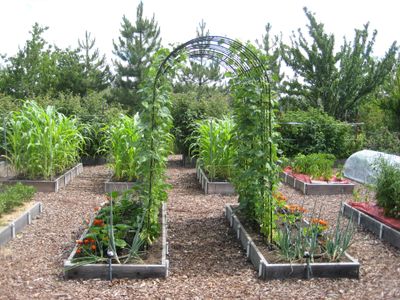Look to an arbor for support

Today’s column is dedicated to the do-it-yourself gardeners out there who are interested in simple projects to help their garden grow more successfully.
As you can see by the photo, the newest addition to our garden is an arbor that supports pole bean vines. We have used standard types of supports in the past but the problem with pole beans is that they are hard to see. You usually stand on the outside of a support and all the beans are hiding on the inside, under the foliage.
We decided to assemble an arbor that spans the aisle between two raised beds so you can walk under it. We made one long arbor by lining up four small arbors purchased at a local garden center. While there is some assembly required, they are very sturdy and should last for years.
We just started picking beans two weeks ago and they hang inside the arbor where I can easily see them.
We cover certain vegetable crops with either a floating row cover to keep insects away, or netting to keep bird beaks and deer lips from tasty plants. But those covers need supports to rest on.
For our 3-by-8-foot raised beds, we cut 1-inch diameter PVC pipes into 10-inch lengths and screwed them in an upright position every 2 feet along the outside of the beds.
Then we created hoops by cutting flexible, ½-inch black sprinkler pipe into 7-foot lengths and inserting each end of the pipe into the PVC uprights. These supports can be seen in the photo as well.
We’ve also made wire covers for some of our beds with leftover 2-by-4s to protect young seedlings from hungry birds. Using 2-by-4s, make a frame with the same dimensions as your beds. Cover it with chicken wire or bird netting and rest the cover on top of the bed.
These can be moved to different beds in early spring to protect germinating seeds.
The best support we’ve ever used for peas is made with panels of 4- by 8-foot concrete reinforcing wire. Buy two of them, stand them up next to each other and use zip-ties or wire to connect the top edges together. Take them to the pea bed and spread the untied bottom edges apart so it looks like a wire pup tent.
A word of caution: It’s always easier to plant the pea seedlings after the wire supports have been put in place; you will risk crushing the seedlings and ruining your day if you do it in reverse order. This support works well for cucumbers, too.
For supporting heavier plants like raspberries, my husband came up with a simple method that has worked great. It requires metal fence posts for the corners and middles of the beds and 10-foot-long metal electrical conduit, which can be found in the electrical section of hardware stores.
He wires two parallel rows of the conduit lengthwise to the fence posts at heights of 20 inches and 38 inches. You can see these supports in the background of today’s photo.
Another use for electrical conduit is in corn beds. Since corn plants have short, stubby roots, a windstorm can easily lay down a whole corn patch.
Many gardeners hill up their plants by adding soil around the base of each cornstalk. Since mine are growing in raised beds, that is not an option. I hammer in a 6-foot length of conduit at each corner of the bed and run twine around the perimeter at heights of about 2 and 3 feet to give the plants the extra support they need.